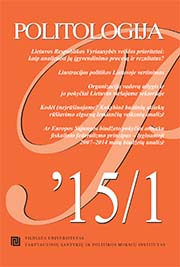AR EUROPOS SĄJUNGOS BIUDŽETO POKYČIAI ATITINKA FISKALINIO FEDERALIZMO PRINCIPUS – LYGINAMOJI 2007–2014 METŲ BIUDŽETŲ ANALIZĖ
DO CHANGES IN THE EUROPEAN UNION BUDGET MEET FISCAL FEDERALISM PRINCIPLES: COMPARATIVE ANALYSIS OF THE 2007–2014 EU BUDGETS
Author(s): Eglė ČeponytėSubject(s): Economy
Published by: Vilniaus universiteto leidykla & VU Tarptautinių santykių ir politikos mokslų institutas
Summary/Abstract: The fiscal federalism theory was developed to explain budget formation in independent states. At present, this theory is often applied to supranational institutions like the European Union (hereinafter EU), without paying enough attention to the unique characteristics of this level of analysis. This article identifies which assumptions of the classical fiscal federalism theory cannot be applied to the supranational level. After modifying these assumptions and adding the public choice theory and political economy insights, the fiscal federalism theory is applied to describe the EU budget. This paper answers the question of whether changes in the EU budget of 2014 were in line with the normative principles of the fiscal federalism. It was found that changes in the EU budget fwere not systematic: while we can see the progress in the implementation of the principles of fiscal federalism in some policy fields, regression and the lack of positive changes are observed in others. Recommendations to the policy makers how the EU budget could be improved are presented in the conclusions. This paper presents a comparative analysis of the policy fields from two multiannual financial frameworks (2007–2013 and 2014–2020 years). It assesses the evolution of the financing (increase, decrease, no change) and the structure of the seven policy areas. The budget of the fiscal year 2007 is considered as the reference point. Financing the analyzed policy fields makes up 80% of the EU budget. The ECORYS Report (ECORYS Nederland BV, 2008) has already given a comprehensive analysis of the 2007 fiscal year budget in accordance to its compliance with the principles of fiscal federalism. The report also discusses the recommended quantitative changes in future budgets. This article evaluates not only the quantitative but also qualitative changes in the EU budgets throughout the period 2007–2014. The agreement about the new multiannual financial framework had to be made under more unfavorable conditions than the last framework. Negotiations involved more than ever players, players’ preferences were very different, the decisionmaking rules were amended – a new institutional authority was added (European Parliament), Euroscepticism significantly increased, finally, some goals of the Europe 2020 are inconsistent with the fiscal federalism principles. Perhaps because of these circumstances, progress in reforming the EU budget in accordance with the principles of fiscal federalism has not happened. Amongst the seven policy fields, positive changes were recorded in four, negative – in two, more negative than positive – in one policy field. Despite the fact that there were positive developments in the vast majority of policy fields, the financing of these fields makes up only ~38.9% of the EU budget. Meanwhile, funding for the remaining three areas consists of ~40.6% of the EU budget (2014 EU budget -142641 million euros).
Journal: Politologija
- Issue Year: 2015
- Issue No: 1 (77)
- Page Range: 200-250
- Page Count: 51
- Language: Lithuanian

